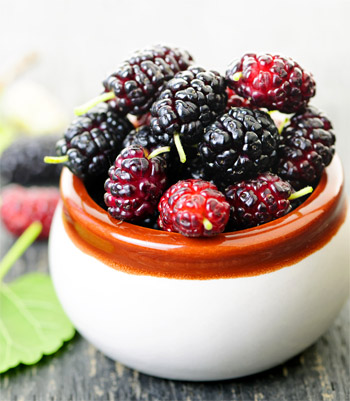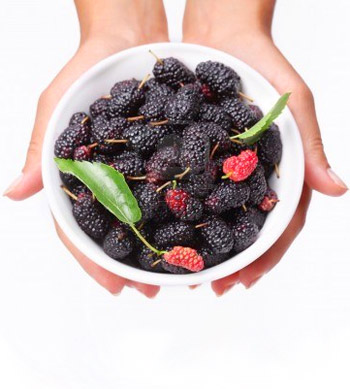|
|
|
 , ,
Font size |
Encyclopedia of Health Benefits of Berries

21. Mulberries:
Most of us will be reminded of the popular nursery rhyme, 'Here we go
round the Mulberry bush'. This is a multiple fruit which has red, purple, or
black fruits. It is used to prepare pies, tarts, cordials, jams, and 'sherbats'.
Refreshingly succulent, tart and sweet mulberries are indeed rich in numerous
health benefiting flavonoid phyto-nutrients. Botanically, the berries are
obtained from the silkworm tree belonging to the Moraceae family within the
genus: Morus. Scientific name: Morus nigra. L. In Spanish, the berries are known
as moras.
More than hundred species of morus exist. In taxonomy, species generally are
identified not by the color of the fruits (berries) but by the color of flower
buds and leaves. So, a morus plant can exhibit different color berries (black,
purple, red, white, etc.) in the same plant.
Three species have been recognized for their economic importance.
The white mulberry (Morus alba) is native to eastern and central China.
The red or American mulberry (Morus rubra) is native to eastern United States.
Black mulberry (Morus nigra) is native to western Asia.
Mulberries are large, deciduous trees native to warm, temperate, and subtropical
regions of Asia, Africa, and the Americas. Technically, the mulberry fruit is an
aggregation of small fruits arranged longitudinally around the central axis as
in blackberry or loganberries. Each fruit measures 2-5 cm long. In most species,
these berries are purple-red when ripen; however, they can be white, red, purple
or multiple colors in the same fruit.
Health benefits of mulberries
Delicious, fleshy, succulent mulberries are low in calories (just 43 calories
per 100 g). They contain health promoting phyto-nutrient compounds like
polyphenol pigment antioxidants, minerals and vitamins that are essential for
optimum health.
 Mulberries have significantly high amounts of phenolic flavonoid phytochemicals
called anthocyanins. Scientific studies have shown that consumption of berries
have potential health effects against cancer, aging and neurological diseases,
inflammation, diabetes, and bacterial infections. Mulberries have significantly high amounts of phenolic flavonoid phytochemicals
called anthocyanins. Scientific studies have shown that consumption of berries
have potential health effects against cancer, aging and neurological diseases,
inflammation, diabetes, and bacterial infections.
The berries contain resveratrol, another polyphenol flavonoid antioxidant.
Resveratrol protects against stroke risk by altering molecular mechanisms in the
blood vessels; reducing their susceptibility to damage through decreased
activity of angiotensin (a systemic hormone causing blood vessel constriction
that would elevate blood pressure) and increased production of the vasodilator
hormone, nitric oxide.
In addition, these berries are an excellent source of vitamin-C (36.4 mg per
100, about 61% of RDI), which is also a powerful natural antioxidant.
Consumption of foods rich in vitamin-C helps the body develop resistance against
infectious agents, counter inflammation and scavenge harmful free radicals.
Further, the berries also contain small amounts of vitamin A, vitamin E and in
addition to the above-mentioned antioxidants. Consumption of mulberry provides
another group of health promoting flavonoid polyphenolic antioxidants such as
lutein, zea-xanthin, �-carotene and α-carotene in small but notably significant
amounts. Altogether, these compounds help act as protect from harmful effects of
oxygen-derived free radicals and reactive oxygen species (ROS) that play a role
in aging and various disease processes.
Zea-xanthin, an important dietary carotenoid selectively concentrates into the
retinal macula lutea, where it thought to provide antioxidant functions and
protects the retina from the harmful ultraviolet rays through light-filtering
actions.
Mulberries are an excellent source of iron, which is a rare feature among
berries, contain 1.85 mg/100 g of fruits (about 23% of RDI). Iron, being a
component of hemoglobin inside the red blood cells, determines the
oxygen-carrying capacity of the blood.
They also good source of minerals like potassium, manganese, and magnesium.
Potassium is an important component of cell and body fluids that helps
controlling heart rate and blood pressure. Manganese is used by the body as a
co-factor for the antioxidant enzyme, superoxide dismutase.
They are rich in B-complex group of vitamins and vitamin K. Contain very good
amounts of vitamin B-6, niacin, riboflavin and folic acid. These vitamins are
function as co-factors and help body in the metabolism of carbohydrates,
proteins and fats.
Next..
Dated 12 March 2013

|
|
|
|
|
|
|









